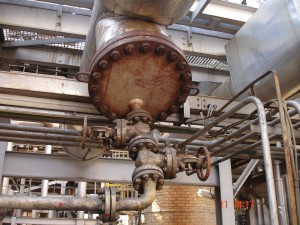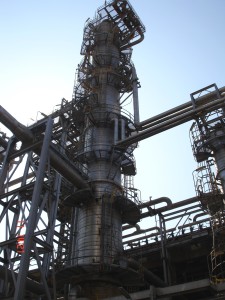Technically Enhanced & Naturally Occurring Radioactive Materials (TENORM/NORM)
All raw materials contain traces of natural radioactivity. The presence of NORM (Naturally Occurring Radioactive Material) in industrial processes receives increased attention from regulatory agencies, health and safety bodies and the operators themselves. This attention becomes more focused where enhancement of natural radioactivity takes place resulting in the generation of TENORM (Technologically Enhanced Naturally Occurring Radioactive Material).
Technologically Enhanced means that the physical, chemical, radiological properties and concentrations [of NORM] have been altered such that there exists a potential for:
- Redistribution and contamination of environmental media (soil, water, and air)
- Increased environmental mobility in soils and groundwater
- Incorporation of elevated levels of radioactivity in products and construction materials
- Improper disposal or use of disposal methods that could result in unnecessary and relatively high exposures to individuals and populations via any environmental pathway and medium
The removal, containment, handling, treatment and disposal of LSA (Low Surface Activity) and NORM/TENORM contamination can be performed on drill piping, casing, separator and a number of other process systems where deposits occur. Using a combination of standard surfactant removal methods and an advanced dry powder cementitious stabilisation agent capable of rapid solidification, partially reducing activity, for safer transportation of decontaminated LSA and NORM/TENORM waste.
THIS provides decontamination services complete with full surveys and assessment in conjunction with their Technical Partners Qa3 who perform full sample capture, on-site Radon activity determination and off-site radionuclide analysis and NORM determination.
Hydrocarbons & Pyrophorics
As with all hydrocarbon process, treatment and refining facilities, prior to accessing the systems for maintenance, inspection or shutdown/turnaround activities the purging and removal of hydrocarbon vapours must be carried out to ensure a VOC, LEL/Gas-free and toxin free atmosphere is achieved.
Most petrochemicals plants and refineries utilise available steam and nitrogen to purge the process equipment however, these techniques require longer time periods and are less effective where there are higher levels of toxins and/or sludge present and additional decontamination may need to be carried out by the sub-contractor before being able to start normal works.
Our experiences and track records have proven that by applying the appropriate decontamination chemicals, into the existing steam purge phase will not only increase the performance capabilities of the purge but also:
- eliminate hydrocarbon-borne vapours from the system vapour spaces by stabilising them as soluble salts
- rapidly breakdown hydrocarbon sludge deposits for easier draining
- deactivate pyrophoric scale and surface activity
- eliminate the release of sulphur dioxide gas (as a result of deactivating any pyrophoric activity)
Using specialty decontamination chemicals shortens this time considerably by a factor of hours, if not days, and helps to attain higher levels of safety for shutdown, maintenance and confined space entry works with less equipment and manpower than usual.
A range of process systems and equipment have been successfully decontaminated including:
- Process Vessels
- Free Water Knock-Out Tank
- Storage Tanks
- Glycol Systems
- Refinery Columns & Towers
- Refinery Process ‘Loops’
- Sour (Sulphur) Treatment Systems
LEL, VOC & Gas-Free
As with all hydrocarbon process, treatment and refining facilities, prior to accessing the system for maintenance, inspection or shutdown/turnaround activities the purging and removal of hydrocarbon vapours must be carried out to ensure a VOC, LEL/Gas-free and toxin free atmosphere is achieved.
Most petrochemicals plants and refineries utilise available steam and nitrogen to purge the process equipment however, these techniques require longer time periods and are less effective where there are higher levels of toxins and/or sludge present and additional decontamination may need to be carried out by the sub-contractor before being able to start normal works.
Our experiences and track records have proven that by applying the appropriate decontamination chemicals, into the existing steam purge phase, will increase the performance capabilities of the purge and eliminate hydrocarbon-borne vapours from the system vapour spaces by stabilising them as soluble salts. Using this specialty decontamination chemical shortens this time considerably by a factor of hours, if not days, and helps to attain higher levels of safety for shutdown, maintenance and confined space entry works with less equipment and manpower than usual.
A range of process systems and equipment have been successfully decontaminated including:
- Process Vessels
- Free Water Knock-Out Tank
- Static Storage Tanks
- Refinery Columns & Towers
- Refinery Process ‘Loops’
- FSO/FPSO Crude Stock Tanks
EXAMPLE:
Crude storage tanks can be completely LEL/VOC/Benzene FREE in a simple application taking little more than a number of hour and NOT the usual 2-3 days using air blowers and extractors.
Fire Prevention Solution
The manufacture, use and storage of aromatic and volatile hydrocarbon-based chemicals creates a potentially invisible but serious hazard for both personnel and facilities. Monitoring programs, detection systems and high power ventilation systems are all employed in these scenarios but there is still issues with pockets of vapours, limitations on extraction and/or movement amongst others.
With the ability to rapidly create a VOC, LEL/Gas-free and toxin free atmosphere it is possible to employ our Hydrocarbon Decontamination technology in to the fire prevention system or a Safety Instrumented System (SIS) as part of an automated response and suppression system.
By applying this unique decontamination chemical, into an existing fire suppression or ‘dousing’ system, you can eliminate aromatic hydrocarbon-borne flammable vapours from the areas’ vapour space and stabilise them as soluble salts, without affecting or corroding any tanks or equipment. Configured in conjunction with the facility detection and monitoring systems it would then be possible to ensure that all vapours are eliminated BEFORE the LEL limit is reached and completely removing the fuel hazard.
This is ideal for use in a range of scenarios including:
- Chemical Blending Facilities
- Chemical Storage Warehouses and Areas
- Transportation & Storage Facilities
- Refineries & Petrochemical Plants and more
Asbestos Abatement
For many years, asbestos was used extensively in heat and acoustic insulation, fire proofing, roofing and flooring as well as pipe insulation and blown-in insulation. Although the use of asbestos and asbestos-products has dramatically decreased, it can still be found in many residential and commercial settings which continue to pose a health risk to workers and others.
The abatement of asbestos requires a methodical application that keeps it surface-bound and prevents ‘friable’ fibres from becoming airborne during the removal and waste handling process. When carried out safely and in this inert state the asbestos can be removed in pre-determined sections and packed accordingly ready for transportation and easier handling at the disposal facility.
Where some process systems may contain asbestos but for some reason, cannot be confirmed due to loss of data or aged systems, a survey complete with sample capture and analysis can be performed prior to finalising engineering or maintenance works to ensure that the correct precautions are taken.















